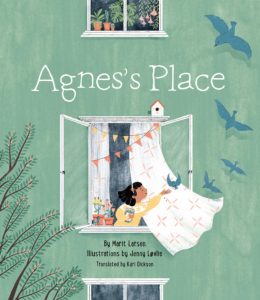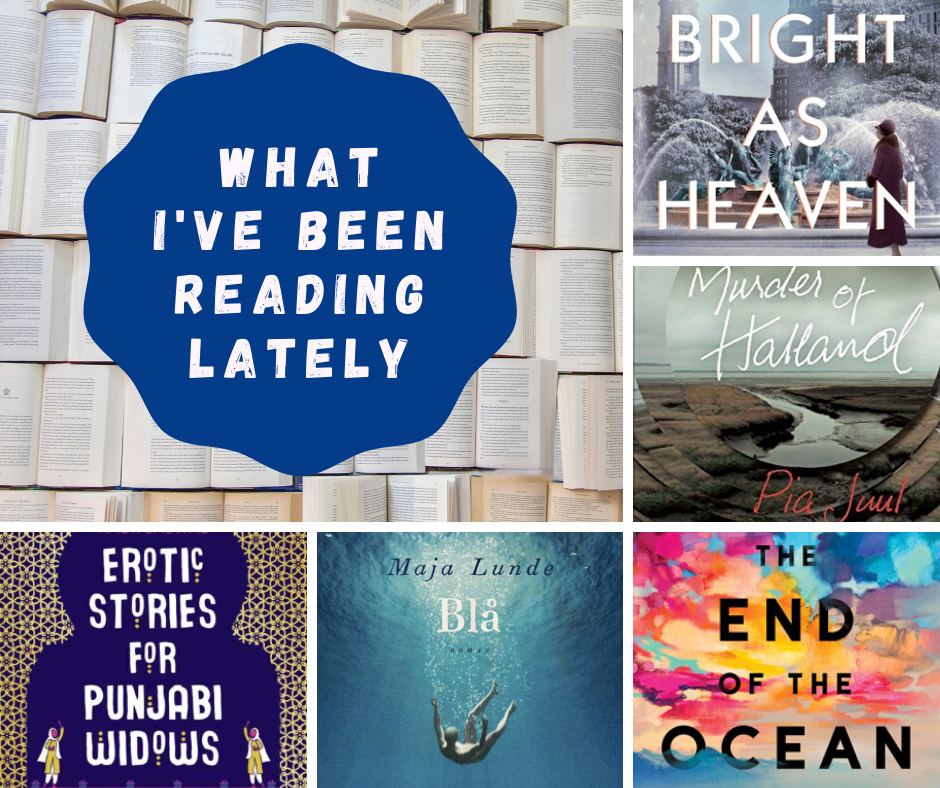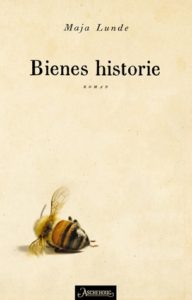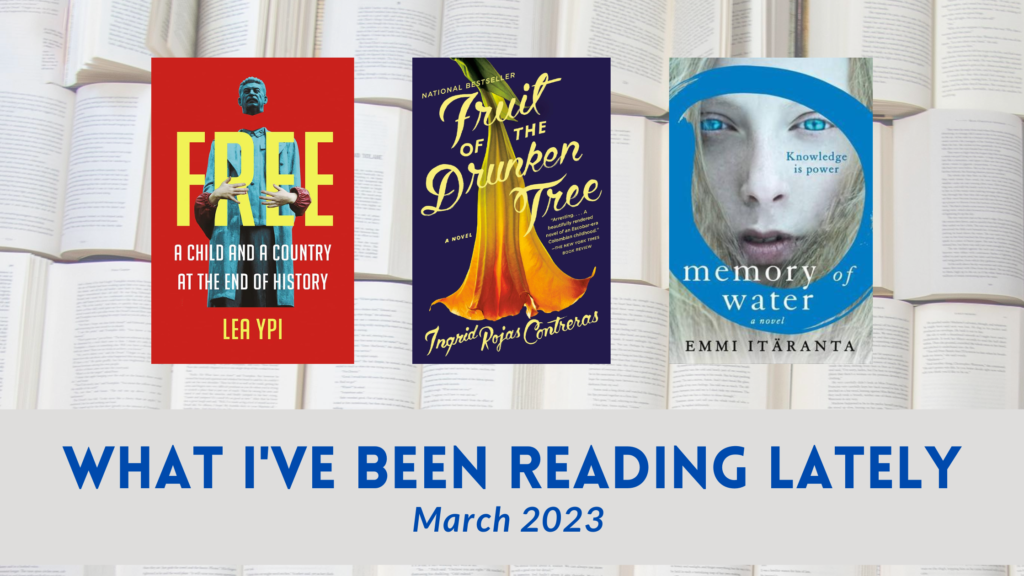Welcome to another round of “What I’ve Been Reading Lately”. The past month has been a ride around the world with visits to Albania, Colombia, and a dystopian, apocalyptic Scandinavia. Coincidentally, I went straight from reading about one country (Albania) during a turbulent decade to a totally different country on the other side of the world (Colombia) in the same decade, also a turbulent one, which is actually not an uninteresting thing to do. The first was a memoir; the second was a novel based on the author’s own experiences. Both were coming of age stories from the perspective of a young girl and provided interesting insight into a country I was not very familiar with at all. Continue reading
Tag Archives: climate fiction
What I’ve Been Reading Lately (August 2022) & #WITmonth Wrap-Up

I continue to join Modern Mrs Darcy’s Quick Lit where we share short and sweet reviews of what we’ve been reading lately.
For me, August was all about reading women in translation for Women in Translation Month. As I’ve written before, I usually focus on female authors outside of Scandinavia for this reading event, but this year I actually focused on Norwegian female authors since I had read so few of them so far this year. Of the two novels I read, one was a recently released debut novel and the other by a favorite author. Both were 5-star reads. Both were also longer books, so I wasn’t able to read as many as I would have liked to.
2022 Scandinavian Reading Challenge Update:
Neither of the novels I read for #WITmonth worked for August’s decade for the reading challenge, the 1980s. I was unable to find one by a Norwegian female author so I started reading Gunnar Staalesen’s Fallen Angels translated by Don Bartlett, a crime novel that takes place in Bergen in the 1980s. For September’s 1990s prompt, I plan to remain in Bergen with Gunnhild Øyehaug’s Present Tense Machine: A Novel translated by Kari Dickson. For details on the reading challenge and insight into the past, current, and next decades, along with a few reading ideas, visit 2022 Scandinavian Reading Challenge.
What have you been reading lately?
Agnes’s Place by Marit Larsen, Illustrated by Jenny Løvlie 📖
(Translated from the Norwegian by Kari Dickson)
 I’m always curious about Norwegian children’s books that are translated into English. What aspects of Norwegian culture are present, if any? There’s nothing particularly Norwegian about this one besides a mention and illustration of heart waffles as a snack. However, noticeable is that the little girl is not your stereotypical white, blonde Norwegian, but instead she has darker skin and black hair. Diverse characters are also featured in the apartment building’s residents. It’s a very sweet book about a 5-year old girl who yearns to connect with a new girl who moves into her apartment building. The illustrations are lovely with lots of detail. This would make a great read-aloud with a young child — so much to observe in the illustrations and to discuss regarding Agnes’ feelings. (Currently available for free via kindle unlimited.)
I’m always curious about Norwegian children’s books that are translated into English. What aspects of Norwegian culture are present, if any? There’s nothing particularly Norwegian about this one besides a mention and illustration of heart waffles as a snack. However, noticeable is that the little girl is not your stereotypical white, blonde Norwegian, but instead she has darker skin and black hair. Diverse characters are also featured in the apartment building’s residents. It’s a very sweet book about a 5-year old girl who yearns to connect with a new girl who moves into her apartment building. The illustrations are lovely with lots of detail. This would make a great read-aloud with a young child — so much to observe in the illustrations and to discuss regarding Agnes’ feelings. (Currently available for free via kindle unlimited.)
Reptile Memoirs: A Novel by Silje Ulstein 🎧
(Translated from the Norwegian by Alison McCullough)
(Narrated by Julie Maisey)
I really enjoyed this one — the characters, the storylines, the structure, the settings, the writing/translation, the twists. It all came together for a great ride. But it’s certainly not for everyone. Not only do you have to keep track of different settings and multiple perspectives (including the snake’s!), but also trigger warnings abound. It’s a thriller that takes place in western Norway – Ålesund in the early 2000s and Kristiansund over 6 days in 2017. In Ålesund, Liv and her housemates spontaneously decide to buy a python and Liv becomes obsessed with it. In Kristiansund, Mariam’s 11-year-old daughter disappears and detectives immediately suspect Mariam. Over time, the two plot lines intersect. As the book jacket says and I can’t say it any better, it is “a brilliantly twisty and unusual literary thriller.” I highly recommend the audiobook. It was an excellent narration.
- Summer Book Bingo: A mystery; Takes place in a country other than the US
The Last Wild Horses: A Novel by Maja Lunde 📖
(Translated from the Norwegian by Diane Oatley)
 This is the third book in Maja Lunde’s The Climate Quartet. I loved the first installment, The History of Bees: A Novel, and enjoyed the second one, The End of the Ocean: A Novel. When I heard the fourth one was expected soon (coming out this Fall 2022 in Norway, English translation TBD), I was very eager to read the third one that I already had on my shelf in Norwegian. I actually alternated between my Norwegian physical copy Przewalskis hest and the English ebook depending on my reading situation/mood. I really enjoyed this one. It jumped between Norway in 2064, Mongolia in 1992, and St. Petersburg/Mongolia in 1882. The thread among the three storylines is the extinction of wild horses, and each of the storylines explores complicated relationships with those closest to us. There were also ties to the first two novels in the quartet which I really appreciated (and caused me to like the second one even more). I highly recommend the quartet and am eagerly anticipating the fourth and final installment.
This is the third book in Maja Lunde’s The Climate Quartet. I loved the first installment, The History of Bees: A Novel, and enjoyed the second one, The End of the Ocean: A Novel. When I heard the fourth one was expected soon (coming out this Fall 2022 in Norway, English translation TBD), I was very eager to read the third one that I already had on my shelf in Norwegian. I actually alternated between my Norwegian physical copy Przewalskis hest and the English ebook depending on my reading situation/mood. I really enjoyed this one. It jumped between Norway in 2064, Mongolia in 1992, and St. Petersburg/Mongolia in 1882. The thread among the three storylines is the extinction of wild horses, and each of the storylines explores complicated relationships with those closest to us. There were also ties to the first two novels in the quartet which I really appreciated (and caused me to like the second one even more). I highly recommend the quartet and am eagerly anticipating the fourth and final installment.
- Summer Book Bingo: Takes place in a country other than the US
What have you been reading lately?
By the way, if you’re interested in purchasing some Scandinavian ebooks at a great discount, visit my Scandinavian Ebook Deals. Some offers stay around for a long time, others only a short period. If anything looks intriguing, grab it before it’s gone.
Disclaimer: AVikingInLA is a participant in the Amazon Services LLC Associates Program, an affiliate advertising program designed to provide a means for sites to earn advertising fees by advertising and linking to amazon.com.
What I’ve Been Reading Lately & My Latest Virtual Book Events (May 2020)

Now that month #3 of staying at home has passed and summertime with its more relaxed schedules is here, I think I’ve finally fallen into a more regular reading rhythm. Two of my favorite times of the day now are when I can sit outside and read during lunchtime and in the early evening.
I continued to attend virtual book events this past month. I thoroughly enjoyed the LA Times’ Book Club conversation with Emily St. John Mandel on May 19. More significantly, I got to “travel” to Norway last month for the Norwegian Festival of Literature in Lillehammer which took place May 29-31. In particular, I enjoyed the panel discussion on Maja Lunde’s success around the world and her lecture as winner of this year’s Bjørnson Prize.
Through my reading this month, I’ve traveled the world in time and place. I’ve experienced 1918 Philadelphia during the Spanish flu pandemic, an Indian immigrant community in London, a small Danish coastal town, and Norway in 2017/France in 2041. Here are my latest reads and listens. Continue reading
In Translation: Maja Lunde’s The History of Bees (Bienes historie)
 Knowing my love of reading and joy in discovering new Norwegian works, my parents gifted me Maja Lunde’s The History of Bees in Norwegian over a year ago. I wish I hadn’t waited so long to read it. It is such an interestingly structured and thought-provoking book about humans’ relationship to bees as well as relationships and expectations between family members. I really enjoyed it and highly recommend it, and luckily, now non-Norwegian readers in the US can enjoy it as well since it very recently came out in translation here.
Knowing my love of reading and joy in discovering new Norwegian works, my parents gifted me Maja Lunde’s The History of Bees in Norwegian over a year ago. I wish I hadn’t waited so long to read it. It is such an interestingly structured and thought-provoking book about humans’ relationship to bees as well as relationships and expectations between family members. I really enjoyed it and highly recommend it, and luckily, now non-Norwegian readers in the US can enjoy it as well since it very recently came out in translation here.
I’m always curious about how works in original language compare to their translated versions. Usually, I just read my Norwegian books in Norwegian, but this time I actually had the opportunity to read it in English as well. (The US publisher Touchstone kindly provided me with a digital advanced readers copy.) I was impressed by Diane Oatley’s translation. It was a very smooth reading experience in English. Nothing jumped out at me as being different from the Norwegian edition. In particular, I was impressed with how well she treated the different language usage by each of the main characters. Continue reading


